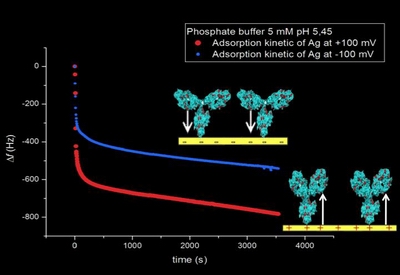ELECTRICAL DRIVE OF BIOLOGICAL REACTIONS AT SURFACES
People
Andrea Alessandrini
Marco Pieruccini
Many biological reactions and phenomena involve the action of charges, dipoles, induced dipoles, and the effect that electric fields exert on them. Examples are numerous including, for instance, redox reactions, conformational variations in enzymes, specific recognition between molecular partners, conformational variations in voltage-gated ion channels, and so on. Electromagnetism on the one hand, and Electronics on the other hand, know very well how to handle electrical phenomena; therefore, the charming possibility arises to manipulate biological reactions and phenomena taking place at electrode surfaces towards implementing biomolecular hybrid devices. Using direct electrochemistry it is possible, for example, to drive the redox state of redox proteins immobilized on a metal electrode or induce conformational modifications in other biomolecules so as to tune their functional activity.
Our research activity in this field regards, currently, the drive of redox reactions in surface chemisorbed metalloproteins [1], the drive of conformation of voltage-gated ion channels in excised biological membranes [2], as well as the modulation of conformation of immobilized antibodies and of the consequent affininty for the corresponding antigens [ 3]. Whereas, in the first case, direct electrochemistry is used to modulate the metalloprotein redox state, and in the second to modulate the opening state of ion channels, in the last it is used to affect the conformation of IgG-type antibodies taking advantage of their positive surface charges. To achieve such a goal one needs to design the Debye lenght of the electric field off the electrode surface by adjusting the solution ionic strength in order to embed the whole molecular length in the potential decay range (typically 10 nm). By changing the electric field polarity, it is possible to vary the conformation of surface immobilized IgGs, pushing or pulling Fab fragments. This action results in the modulation of antibody-antigen affinity exploiting steric hindrance Fab fragments ondergo when they are pulled towards the electrode surface. We envisage to apply a similar approach also to the modulation of enzyme activity by controlling their conformation at surface.
 |
|
Fig 1. Kinetics of IgG-antigen adsorption as a function of the applied potential
|
Publications
The Redox Chemistry of the Covalently Immobilized Native and Low-pH Forms of Yeast Iso-1-cytochrome c
C.A. Bortolotti, G. Battistuzzi, M. Borsari, P. Facci, A. Ranieri, M. Sola
J. Am. Chem. Soc., ,128, 5444 (2006)
Voltage-induced morphological modifications in oocyte membranes containing exogenous K+ channels studied by electrochemical scanning force microscopy
A. Alessandrini, P. Gavazzo, C. Picco, and P. Facci
Microsc. Res. Tech., 71, 274 (2008)
Manuscript in preparation. (2012)
M.L. Caiazzo, A. Alessandrini, and P. Facci